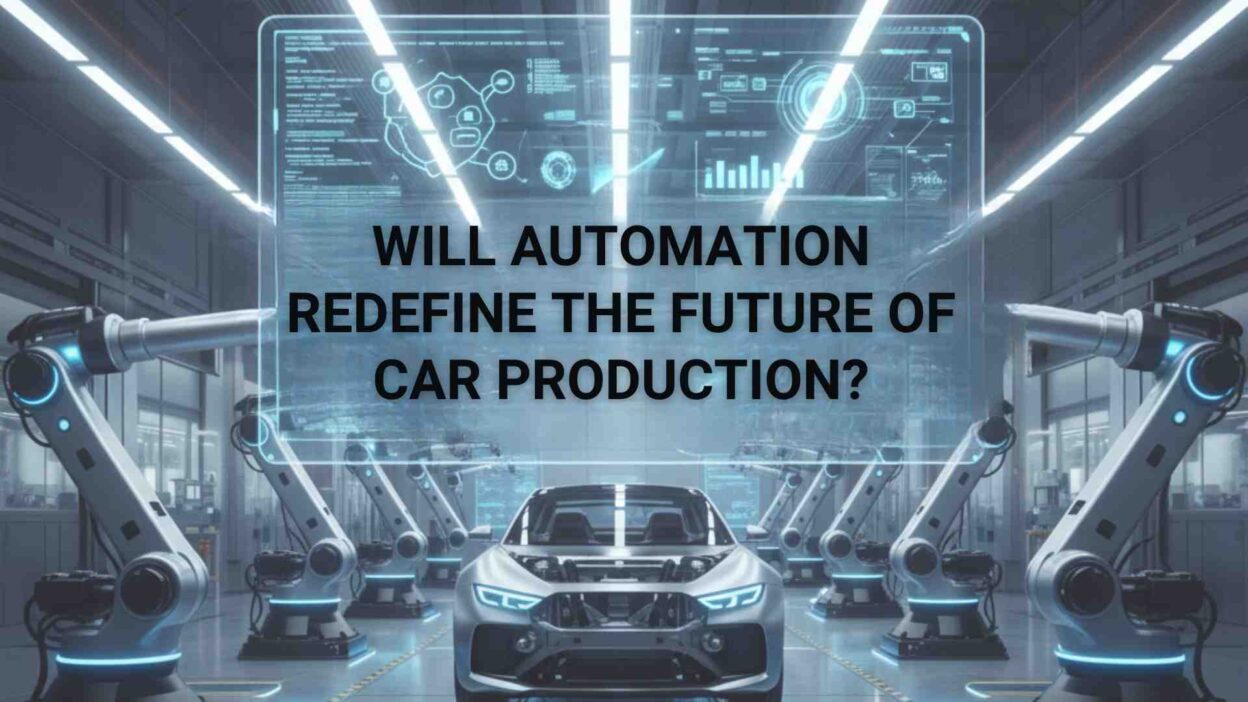TL;DR The automotive industry stands at a crossroads. Manufacturing plants worldwide buzz with robotic arms. Assembly lines move faster than ever before. The future of automation in the automotive sector promises radical changes. Car production methods that worked for decades now face disruption. Automotive robotics technology shapes every aspect of manufacturing today.
Table of Contents
Traditional assembly methods gave way to smart machines. Human workers once dominated factory floors. Now robots handle precision tasks with incredible accuracy. The transformation started slowly but gained momentum. Today’s factories look nothing like those from twenty years ago.
Understanding Automation in Modern Car Manufacturing
Car makers invest billions in robotic systems. These investments reshape production capabilities entirely. Automotive robotics technology brings precision to complex tasks. Welding joints require exact measurements every time. Painting requires consistent coverage without human error. Assembly demands repetition that never wavers.
Robots excel at tasks humans find challenging. Heavy lifting poses no problem for mechanical arms. Dangerous environments don’t affect machine performance. Quality control becomes more consistent through automation. Each vehicle rolls off the line meeting strict standards.
The shift toward automation accelerates yearly. Market demands push manufacturers toward efficiency. Competition forces innovation in production methods. Companies that resist change risk falling behind. Those adopting the future of automation in the automotive sector gain advantages.
Current State of Factory Automation
Modern plants operate with remarkable efficiency. Sensors track every movement on assembly lines. Data flows continuously to control centers. Managers monitor production in real-time. Problems get identified before they escalate.
Robotic welders handle body construction. Paint booths operate with minimal human oversight. Quality inspection uses computer vision systems. Material handling relies on automated guided vehicles. Each system connects to create seamless workflows.
Safety improves dramatically with automated systems. Workers face fewer hazardous situations daily. Ergonomic issues decrease significantly. Injury rates drop in automated facilities. Human roles shift toward supervision and maintenance.
Key Technologies Driving Change
Several technologies power automotive robotics technology today. Artificial intelligence enables adaptive learning. Machine learning improves processes over time. Computer vision identifies defects instantly. Collaborative robots work alongside human teams.
Internet of Things connects factory equipment. Cloud computing processes vast data volumes. Digital twins simulate production scenarios. Predictive maintenance prevents unexpected downtime. These technologies work together harmoniously.
Sensor technology continues advancing rapidly. Cameras capture microscopic details clearly. Force sensors detect pressure variations precisely. Position sensors ensure perfect alignment. Temperature monitors maintain optimal conditions.
The Evolution of Automotive Robotics Technology
Early robots performed simple repetitive tasks. They operated in caged areas away from workers. Programming required specialized knowledge. Flexibility was limited significantly. Changes took time to implement.
Modern robots demonstrate remarkable capabilities. They adapt to varying conditions quickly. Programming becomes intuitive through user interfaces. Safety features allow human collaboration. Deployment happens faster than before.
First Generation Manufacturing Robots
Initial automotive robots focused on welding. Spot welding suited robotic precision perfectly. These machines operated on fixed programs. They repeated motions endlessly without variation. Changeovers required extensive reprogramming.
Paint application came next in automation. Consistent coverage proved challenging for humans. Robots delivered uniform coating thickness. Overspray reduced dramatically. Quality improved while waste decreased.
Material handling robots appeared subsequently. They moved heavy components between stations. Stamping operations gained robotic assistance. Part positioning became more accurate. Cycle times shortened considerably.
Modern Intelligent Systems
Today’s robots incorporate advanced sensors. They respond to environmental changes dynamically. Vision systems guide precise movements. Force feedback prevents damage during assembly. Adaptive grippers handle varying part sizes.
Collaborative robots represent major breakthroughs. They work safely beside human operators. No safety cages are required anymore. Workers teach robots through demonstration. Flexibility reaches unprecedented levels.
Artificial intelligence transforms robotic capabilities. Systems learn from experience continuously. Performance optimization happens automatically. Defect detection improves over time. Decision-making becomes more sophisticated.
Integration with Smart Factory Concepts
The future of automation in the automotive sector embraces connectivity. Every machine communicates with others seamlessly. Production data flows to analytics platforms. Managers receive insights instantly. Adjustments happen in real-time.
Digital twins create virtual factory replicas. Engineers test changes before implementation. Risks get evaluated without disrupting production. Optimization scenarios run continuously. Best practices emerge from simulation.
Augmented reality assists human workers. Instructions appear through smart glasses. Complex assemblies become easier to complete. Training time reduces significantly. Error rates drop substantially.
Benefits Transforming Car Production
Automation delivers measurable advantages. Production costs decrease over time. Quality levels rise consistently. Output volumes increase substantially. Manufacturers gain competitive edges.
Enhanced Production Speed
Robots never tire during shifts. They maintain consistent speeds always. Cycle times shrink dramatically. More vehicles complete production daily. Delivery schedules become more reliable.
Changeover times reduce significantly. Robots adapt to new models quickly. Production lines switch products faster. Flexibility increases without sacrificing speed. Market responsiveness improves notably.
Bottlenecks get eliminated systematically. Balanced production flows emerge naturally. Idle time decreases across operations. Overall equipment effectiveness rises. Maximum capacity gets utilized efficiently.
Superior Quality Control
Automotive robotics technology ensures precision. Measurements stay within tight tolerances. Defects decrease to minimal levels. Rework requirements drop substantially. Customer satisfaction improves measurably.
Consistency defines automated production. Every weld meets exact specifications. Paint thickness remains uniform throughout. Assembly torques hit targets precisely. Variations disappear from processes.
Vision systems inspect every component. Defects get caught immediately. Bad parts never progress downstream. Waste reduces significantly. Cost savings accumulate quickly.
Cost Efficiency Over Time
Initial investments seem substantial. Long-term savings justify expenses clearly. Labor costs stabilize predictably. Productivity gains compound yearly. Return on investment materializes rapidly.
Energy consumption optimizes automatically. Robots use power efficiently. Waste materials decrease substantially. Maintenance becomes predictive rather than reactive. Downtime shrinks to minimal levels.
Space utilization improves significantly. Compact robots occupy less floor area. Vertical integration becomes possible. Facility footprints shrink accordingly. Real estate costs decrease.
Worker Safety Improvements
Dangerous tasks move to robots. Exposure to hazards decreases dramatically. Repetitive strain injuries become rare. Accident rates fall substantially. Insurance costs reduce accordingly.
Ergonomic conditions improve for humans. Heavy lifting disappears from job descriptions. Awkward positions become unnecessary. Physical stress decreases significantly. Worker health improves overall.
Chemical exposures get eliminated. Paint fumes affect robots negligibly. Welding hazards pose no risk. Temperature extremes don’t matter. Workplace environments become safer.
Challenges Facing Automotive Automation
Progress brings obstacles inevitably. Implementation requires careful planning. Costs present significant hurdles initially. Workforce transitions need management. Technical complexities arise regularly.
Initial Capital Requirements
Robotic systems demand substantial investments. Small manufacturers struggle with costs. Equipment expenses run high initially. Infrastructure upgrades prove necessary. Financial barriers limit adoption.
Integration costs add significantly. Existing systems need modifications. Training programs require funding. Consultants charge premium rates. Total expenses exceed equipment costs.
Financing options help somewhat. Leasing arrangements spread costs. Government incentives encourage adoption. Industry partnerships share expenses. Creative solutions emerge continuously.
Workforce Displacement Concerns
Automation reduces certain job types. Assembly line positions decrease notably. Manual labor roles diminish gradually. Communities face employment challenges. Social impacts require attention.
Retraining programs address transitions. Workers learn new skills actively. Technical roles increase significantly. Maintenance positions grow steadily. Education becomes critically important.
Human expertise remains valuable. Complex problem-solving needs people. Creativity can’t be automated yet. Strategic thinking requires human minds. Collaboration between humans and machines works best.
Technical Integration Complexity
Legacy systems complicate automation. Older equipment lacks connectivity. Data formats vary significantly. Communication protocols differ widely. Standardization challenges persist.
The future of automation in the automotive sector requires interoperability. Different manufacturers use varying systems. Integration demands careful engineering. Compatibility issues arise frequently. Solutions require custom development.
Cybersecurity concerns grow constantly. Connected systems face threats. Data protection becomes paramount. Network security requires vigilance. Risks multiply with connectivity.
Maintenance and Technical Expertise
Automotive robotics technology needs specialized knowledge. Technicians require extensive training. Skills shortages affect industries. Experienced professionals command premium salaries. Talent acquisition proves challenging.
Maintenance complexity increases significantly. Systems need regular updates. Software patches deploy frequently. Hardware components wear eventually. Spare parts availability matters greatly.
Predictive maintenance helps considerably. Sensors monitor equipment health continuously. Analytics predict failures before occurrence. Scheduled maintenance prevents surprises. Uptime improves dramatically.
Future Trends Shaping Production
Innovation never stops in manufacturing. New technologies emerge constantly. The future of automation in the automotive sector evolves rapidly. Tomorrow’s factories will amaze us. Possibilities seem limitless today.
Artificial Intelligence Integration
AI transforms manufacturing capabilities fundamentally. Machine learning optimizes processes automatically. Neural networks identify patterns humans miss. Deep learning improves quality control. Cognitive computing enhances decision-making.
Predictive analytics forecasts demand accurately. Production schedules optimize automatically. Inventory management becomes incredibly efficient. Supply chain coordination improves dramatically. Waste is reduced to a theoretical minimum.
Generative design creates optimal components. AI suggests manufacturing methods. Process parameters self-optimize continuously. Energy consumption is minimized automatically. Sustainability improves substantially.
Collaborative Robot Evolution
Cobots become increasingly capable. Safety features advance continuously. Human-robot interaction grows more natural. Workspaces integrate seamlessly. Productivity multiplies significantly.
Programming becomes intuitive. Workers teach robots easily. No coding knowledge is required. Deployment happens rapidly. Flexibility reaches new heights.
Adaptive capabilities expand constantly. Robots handle a greater variety. Complex tasks become manageable. Learning happens continuously. Performance improves over time.
Electric Vehicle Manufacturing
Electric vehicles demand different production. Battery assembly requires precision. Electric motor manufacturing differs significantly. Automotive robotics technology adapts accordingly. New processes emerge constantly.
Simplified powertrains change manufacturing. Fewer moving parts need assembly. Production complexity decreases somewhat. Cycle times shorten potentially. Efficiency gains materialize.
Battery production grows exponentially. Cell manufacturing needs automation. Pack assembly demands precision. Quality control becomes critical. Safety requirements stay stringent.
Sustainable Manufacturing Practices
Environmental concerns drive innovation. Energy efficiency improves continuously. Waste reduction remains a priority. Carbon footprints shrink steadily. Green manufacturing gains importance.
Robots enable sustainable practices. Precise material usage reduces waste. Energy consumption optimizes automatically. Recycling becomes easier. Circular economy principles apply.
Water usage decreases significantly. Chemical consumption drops substantially. Emissions fall dramatically. Environmental compliance improves. Regulatory requirements are met easily.
Regional Adoption Patterns
Automation spreads unevenly worldwide. Developed markets lead adoption. Emerging economies catch up gradually. Regional factors influence implementation. Cultural attitudes affect acceptance.
North American Manufacturing
The United States invests heavily. Canada follows similar patterns. Mexico grows manufacturing capabilities. Automotive robotics technology proliferates rapidly. Competition drives innovation constantly.
Labor costs influence decisions. Skilled worker shortages accelerate automation. Productivity improvements justify investments. Quality demands require precision. Market pressures force changes.
Government policies support manufacturing. Tax incentives encourage investment. Research funding flows steadily. Educational programs train workers. Infrastructure improvements continue.
European Production Evolution
Germany leads European automation. Industry 4.0 originated there. Other nations follow examples. The future of automation in the automotive sector is widely embraced. Innovation hubs flourish.
Environmental regulations drive changes. Efficiency requirements tighten continuously. Emissions standards become stricter. Sustainability demands increase. Green technologies proliferate.
Labor relations shape implementation. Worker councils influence decisions. Social considerations matter greatly. Transition programs get prioritized. Human factors receive attention.
Asian Manufacturing Powerhouses
China invests astronomically. Japan maintains technological leadership. South Korea advances rapidly. India develops capabilities steadily. Competition intensifies continuously.
Market size drives investments. Domestic demand grows substantially. Export opportunities remain strong. Manufacturing scales impressively. Capacity expands constantly.
Government support proves substantial. Industrial policies favor automation. Research funding flows generously. Educational systems adapt. Technical expertise develops rapidly.
Impact on Supply Chain Management
Automation extends beyond factories. Supply chains transform completely. Logistics become highly efficient. Inventory management optimizes. Coordination improves dramatically.
Just-in-Time Manufacturing
The future of automation in the automotive sector enables precision timing. Parts arrive exactly when needed. Inventory levels have decreased dramatically. Storage costs decrease significantly. Cash flow improves substantially.
Supplier coordination becomes critical. Communication happens in real-time. Delivery schedules synchronize perfectly. Quality requirements stay strict. Relationships deepen significantly.
Risks require careful management. Disruptions affect systems quickly. Backup plans prove essential. Flexibility remains important. Resilience gets built systematically.
Quality Assurance Throughout Supply Chain
Automotive robotics technology ensures consistency. Suppliers adopt similar systems. Standards align across networks. Quality improves universally. Defects become increasingly rare.
Traceability improves significantly. Every component tracks digitally. Origins remain transparent always. Problems get identified quickly. Recalls become more targeted.
Data sharing increases substantially. Performance metrics flow freely. Analytics identify improvement opportunities. Collaboration intensifies naturally. Ecosystems strengthen continuously.
Economic Implications
Automation reshapes automotive economics. Business models transform fundamentally. Competition intensifies globally. Profit margins change substantially. Industry structures evolve constantly.
Competitive Advantages
Early adopters gain significantly. Production costs decrease substantially. Quality levels rise dramatically. Market share grows accordingly. Profitability improves noticeably.
Flexibility becomes a key differentiator. Quick model changes attract customers. Customization becomes economically viable. Market responsiveness improves. Customer satisfaction rises.
Innovation speeds up considerably. New features deploy faster. Testing happens more thoroughly. Time-to-market shrinks dramatically. Competitive edges sharpen.
Market Consolidation Trends
Large manufacturers are increasingly. Small players struggle financially. Mergers happen more frequently. Industry concentration grows. Competition constantly reshapes.
Technology costs favor scale. Shared investments make sense. Partnerships form strategically. Alliances strengthen capabilities. Ecosystems develop naturally.
Startups face higher barriers. Innovation still happens actively. Disruption remains possible always. Agility provides advantages. Creativity matters greatly.
Preparing for the Automated Future
Success requires strategic planning. Organizations must adapt continuously. Investment decisions carry weight. Workforce development proves critical. Culture changes become necessary.
Strategic Planning Essentials
Vision matters tremendously. Leadership must commit fully. Roadmaps need careful development. Timelines require a realistic assessment. Resources must align properly.
The future of automation in the automotive sector demands preparation. Technology assessments happen regularly. Gap analyses identify needs. Investment priorities get established. Implementation plans are developed thoroughly.
Stakeholder engagement proves essential. Employees need involvement early. Suppliers must align appropriately. Customers deserve consideration. Communities warrant attention.
Workforce Development Programs
Training investments pay dividends. Employees learn new skills actively. Technical capabilities develop steadily. Career paths evolve naturally. Job satisfaction improves.
Educational partnerships matter greatly. Universities provide talent pipelines. Community colleges train workers. Apprenticeship programs work well. Continuous learning becomes cultural.
Change management requires attention. Communication happens transparently. Concerns get addressed promptly. Support systems function effectively. Transitions happen smoothly.
Technology Investment Strategies
Phased approaches work well. Pilot projects test concepts. Learnings inform decisions. Scaling happens deliberately. Risks are managed carefully.
Vendor selection matters greatly. Partnerships require careful evaluation. Compatibility needs verification. Support capabilities matter. Long-term relationships develop.
Flexibility remains important always. Technologies evolve constantly. Adaptability provides advantages. Future-proofing makes sense. Modularity helps significantly.
Frequently Asked Questions
How does automotive robotics technology improve car quality?
Robots deliver consistent precision. Every movement follows exact specifications. Measurements stay within tight tolerances. Human error disappears completely. Defect rates drop dramatically. Vision systems catch problems immediately. Quality control becomes incredibly reliable.
Will automation eliminate all human jobs in car manufacturing?
Automation changes job types substantially. Some roles disappear gradually. New positions emerge constantly. Technical skills become more valuable. Human expertise remains essential. Creativity can’t be automated. Supervision roles increase significantly. Collaboration between humans and machines works best.
What makes the future of automation in the automotive sector inevitable?
Market competition drives adoption. Efficiency demands keep increasing. Quality expectations rise continuously. Cost pressures never relent. Technology advances relentlessly. Consumer preferences evolve constantly. Sustainability requirements tighten. Global competition intensifies dramatically.
How much does factory automation cost initially?
Initial investments vary widely. Small installations cost hundreds of thousands. Large facilities require millions. Integration expenses add significantly. Training programs need funding. Infrastructure upgrades prove necessary. Total costs depend on the scope. Return on investment takes time.
Which car manufacturers lead in automation adoption?
German automakers pioneer extensively. Japanese companies innovate constantly. American manufacturers invest heavily. Chinese producers scale rapidly. Korean firms advance quickly. Competition drives everyone forward. Technology leadership shifts periodically. Innovation happens industry-wide.
Can small manufacturers afford automotive robotics technology?
Costs present challenges initially. Financing options help considerably. Leasing arrangements spread expenses. Collaborative robots cost less. Scalable solutions exist now. Partnerships share investments. Government incentives encourage adoption. Creative approaches work.
What skills will future automotive workers need?
Technical knowledge becomes essential. Programming skills matter greatly. Data analysis capabilities help. Problem-solving remains critical. Mechanical understanding stays relevant. Electrical knowledge is growing in importance. Software literacy proves necessary. Continuous learning becomes mandatory.
Read More: AI Voice Assistants for Municipalities & Utilities
Conclusion

The automotive industry transforms before our eyes. Manufacturing plants evolve into smart factories. Traditional methods give way to innovation. Automotive robotics technology drives unprecedented changes. Production capabilities expand dramatically.
The future of automation in the automotive sector is arriving rapidly. Robots handle tasks with incredible precision. Quality reaches new heights consistently. Efficiency improvements compound over time. Cost structures are fundamental. Challenges exist, but solutions emerge constantly. Initial investments prove substantial yet worthwhile. Workforce transitions require careful management. Technical complexities demand expertise. Organizations adapt through strategic planning.
The future of automation in the automotive sector isn’t coming someday. That future exists right now. Plants worldwide demonstrate capabilities daily. Results speak loudly. Success stories multiply continuously. Automation will redefine car production completely. This transformation proves inevitable. Market forces drive changes relentlessly. Technology advances unstoppably. Competition intensifies constantly.
Manufacturers ready themselves accordingly. Investments flow toward automation. Capabilities develop systematically. Expertise builds gradually. Organizations position themselves strategically. The question isn’t whether automation redefines production. The question becomes how quickly the transformation happens. How thoroughly industries adapt, effectively organizations prepare and successfully workers transition.






[…] Read More: Will Automation Redefine the Future of Car Production? […]